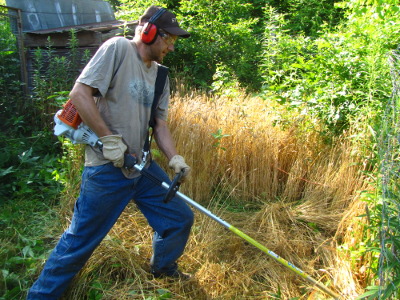
Do-nothing grain experiments
 Before I tell you how to make
a seed ball, I wanted to catch you up on a year and a half of
do-nothing grain experiments. The goal is to create a nearly
self-sufficient grain patch using Fukuoka's
natural gardening techniques but tweaked to match the
southeastern U.S.'s climate.
Before I tell you how to make
a seed ball, I wanted to catch you up on a year and a half of
do-nothing grain experiments. The goal is to create a nearly
self-sufficient grain patch using Fukuoka's
natural gardening techniques but tweaked to match the
southeastern U.S.'s climate.
Experiment one consisted
of leaving the chicken tractor on a patch of ground for a month in late
winter 2010, then throwing
hull-less oat and red clover seeds onto the bare soil. Wild birds ate a lot
of the oat seeds and the chickens hadn't really killed the perennial
grasses and weeds, so I ended up with a
very small showing of oats and a healthy patch of red clover (still quite visible in the
yard.)
 For part two of my do-nothing
experimentation, I decided to move my patch to the nearly bare earth of
our first, over-grazed chicken pasture. Mark helped me root out
most of the perennials left in place, then I raked buckwheat and red
clover seeds into the soil in late June 2010. The buckwheat came
up well, but didn't
do as much as I'd hoped because of lack of water. (The red clover
didn't seem to come up at all.) I turned the chickens into the
buckwheat paddock in October, and they ate up the bit of buckwheat that
was produced in a mere four days.
For part two of my do-nothing
experimentation, I decided to move my patch to the nearly bare earth of
our first, over-grazed chicken pasture. Mark helped me root out
most of the perennials left in place, then I raked buckwheat and red
clover seeds into the soil in late June 2010. The buckwheat came
up well, but didn't
do as much as I'd hoped because of lack of water. (The red clover
didn't seem to come up at all.) I turned the chickens into the
buckwheat paddock in October, and they ate up the bit of buckwheat that
was produced in a mere four days.
Although the yields were
disappointing, the good thing about the buckwheat experiment was that
the combination of the crop and the chickens' harvest method deleted
nearly all weeds from that paddock. I had no trouble raking
wheat seeds into the ground near the end of October, and
the
grain grew pretty well
(although I think it suffered from overseeding and perhaps a small
drought.)
 Despite my growing pains
starting the do-nothing system, I can tell that I'm starting to develop
the kind of planting Fukuoka was advocating. When we
cut the wheat a
couple of weeks ago, I noticed clover sprouting up through the dead
stalks, just like Fukuoka predicted. Those red clover seeds had
sat in the ground until they were ready to grow, and are now busy
fixing atmospheric nitrogen to fertilize the grain field.
Despite my growing pains
starting the do-nothing system, I can tell that I'm starting to develop
the kind of planting Fukuoka was advocating. When we
cut the wheat a
couple of weeks ago, I noticed clover sprouting up through the dead
stalks, just like Fukuoka predicted. Those red clover seeds had
sat in the ground until they were ready to grow, and are now busy
fixing atmospheric nitrogen to fertilize the grain field.
The wheat stubble is
tenaciously holding the soil in place too, which brings me at last to
the subject of this week's lunchtime series --- seed
balls. I
needed a way of getting the next round of grain seeds to sprout without
hoeing up the soil, so I decided to give seed balls a try. Stay
tuned for tomorrow's post to see how I went about it.
| This post is part of our Seed Ball lunchtime series.
Read all of the entries: |
Want more in-depth information? Browse through our books.
Or explore more posts by date or by subject.
About us: Anna Hess and Mark Hamilton spent over a decade living self-sufficiently in the mountains of Virginia before moving north to start over from scratch in the foothills of Ohio. They've experimented with permaculture, no-till gardening, trailersteading, home-based microbusinesses and much more, writing about their adventures in both blogs and books.
Want to be notified when new comments are posted on this page? Click on the RSS button after you add a comment to subscribe to the comment feed, or simply check the box beside "email replies to me" while writing your comment.
- Remove comment

- Remove comment
